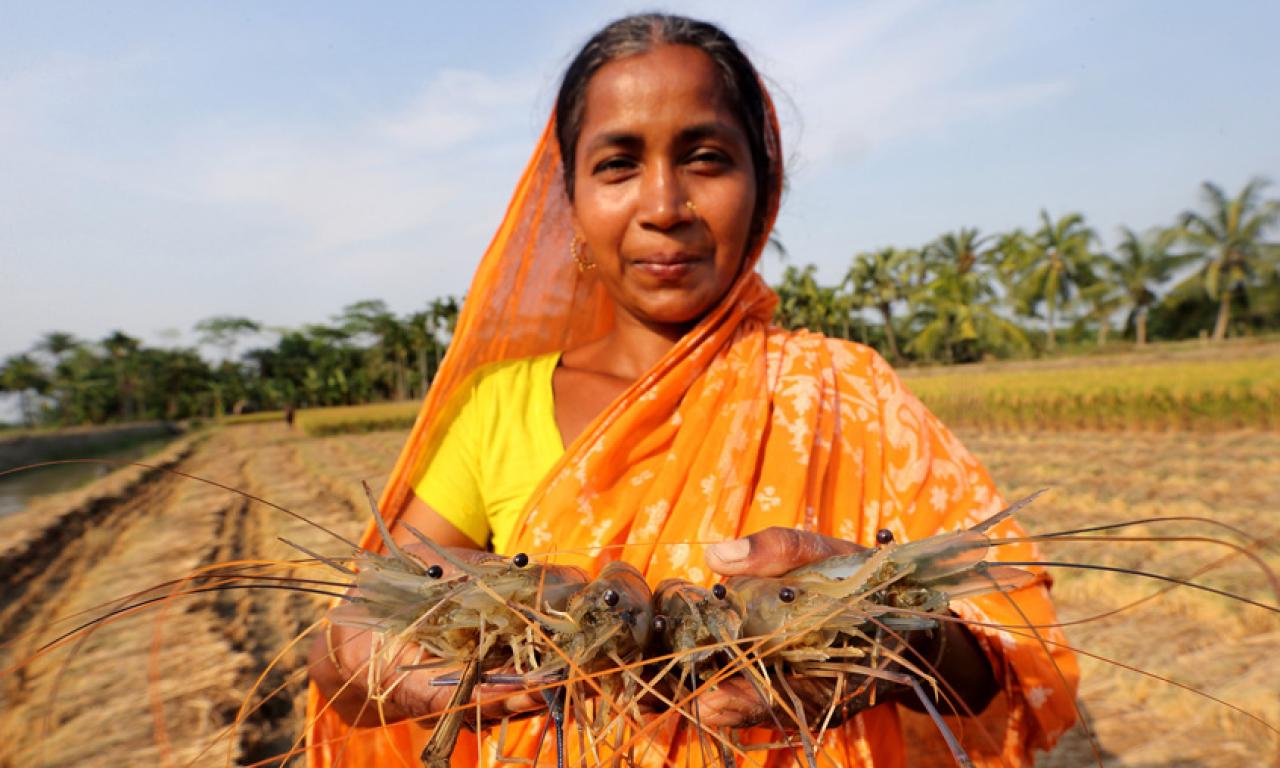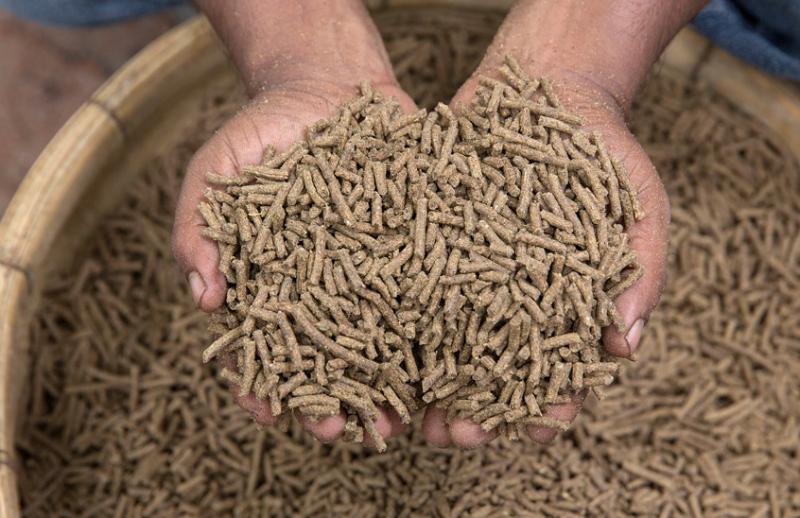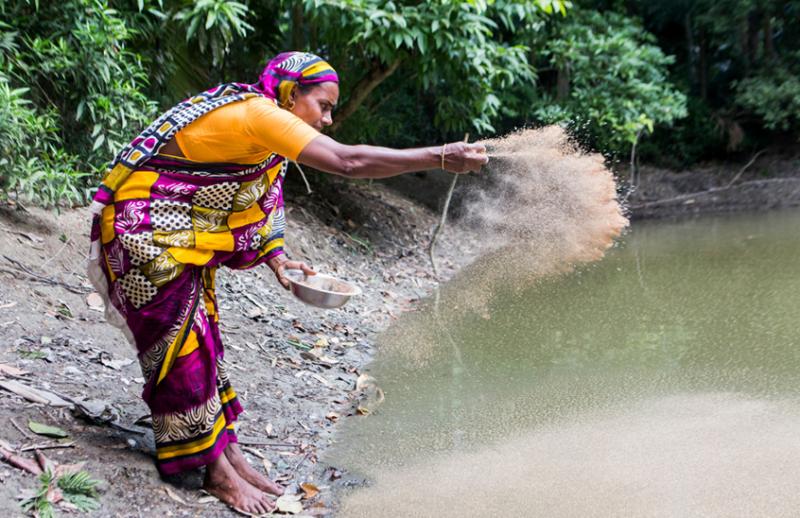
A breakthrough aquafeed ingredient that greatly reduces the need for wild-harvest fishmeal has potential to boost the productivity of small-scale shrimp and fish farmers in developing countries.
Recommended publications
Currently, around 17 million metric tons of fish, one fifth of the global fish catch, is used to produce fish feeds for aquaculture.
But a breakthrough innovation developed by CSIRO scientists in Australia in 2009, known as Novacq (an abbreviation of novel aquafeed), is helping to reduce reliance on harvesting wild fish to feed to farmed fish and crustaceans. Novacq is an aquafeed ingredient produced by marine microbes that, when used in a shrimp feed, results in 20-30% faster growing and healthier farmed shrimp.
Now, WorldFish aims to make Novacq available to smallholder shrimp and fish farmers in developing countries, where aquaculture is growing rapidly yet yields are often low.
With funding from the Blue Economy Challenge grant program, WorldFish will next year start field trials in Bangladesh, Indonesia, Malaysia and Tanzania – the critical first step to bringing Novacq to market in these and other counties in the Indian Ocean region from 2018 onwards.
Novacq: A novel innovation
Most commercial fish and crustacean farmers feed their fish with pellets that typically contain 25–65 percent fish meal and fish oil. Inclusion of these ingredients reflects the food that farmed fish and crustaceans would eat if in the wild. It also assists their growth and produces a high-quality and healthy product for consumers.
Yet with the world’s wild fish stocks under pressure, this practice is unsustainable and represents a critical threat to the long-term viability of the global aquafeed industry and aquaculture.
Until recently, global efforts had failed to find suitable alternative feeds that matched or improved the cost and nutritional performance of wild fish products while reducing the burden on the natural environment.

But scientists at the Commonwealth Scientific and Industrial Research Organization (CSIRO) in Australia have done this, after 10 years of research, by developing the Novacq additive. This represents a world-first achievement in the sustainability and cost-effectiveness of aquafeeds.
The technology uses natural marine microbial processes to bio-convert plant wastes, such as rice straw, into a bioactive powder (Novacq). Including 5–10 percent of Novacq in shrimp feeds improves the growth and health of farmed shrimp and greatly reduces or eliminates the need for any wild harvest fishmeal.
Since 2014, the technology has been in full-scale commercial production in China and Vietnam, two of the world’s largest aquaculture-producing countries. Shrimp farmers in these countries have seen impressive improvements in growth rates of 20% to 30% and the commercial market for Novacq is anticipated to increase rapidly as more shrimp farmers adopt the technology.
The potential of Novacq for smallholder farmers
Determining if these gains can be achieved when Novacq is used in fish feed, including when used in small-scale aquaculture production, is now the focus of research by WorldFish.
Small-scale aquaculture is on the rise in many developing countries, where millions of households depend on it for their livelihoods. In Bangladesh, for example, aquaculture production has expanded quickly over the last 10 years, with inland aquaculture production growing an average of 12% each year between 2006 and 2014.
Fish and crustacean farming represent a vital source of food and income, as well as a good source of micronutrients and vitamins, which are vital for good health and development but are often missing from the diets of the poor.
Yet access to quality feeds remain a problem, particularly for the poor, who cannot afford to buy pre-packaged feeds, and rural farmers that live far away from a local feed mill. Faced with this challenge, many have to feed their fish or shrimp with local ingredients such as rice bran, cassava and small wild harvest fish, often called trash fish. The use of trash fish places increasing pressure on declining wild fisheries.

The bioactive properties of Novacq enable shrimp farmers to produce feeds without any wild harvest fish products and with no loss of the nutritional performance of the feeds. Now, WorldFish will conduct research to confirm if Novacq and associated feed formulations will offer the same benefits when used in fish feeds in developing countries.
Preliminary results of Novacq trials by others with juvenile barramundi (Lates calcarifer) has shown noticeable increases in growth rates. We anticipate that similar or better results could be achieved in Nile tilapia (Oreochromis niloticus), a species of increasing important to smallholder fish farmers in the Indian Ocean region.
Starting in 2017, WorldFish will conduct on-farm research trials with smallholder shrimp and fish farmers in four countries (Bangladesh, Indonesia, Malaysia and Tanzania). These trials aim to determine the optimal combination of local feed ingredients to be used with Novacq and demonstrate the likely on-farm yield gains.
Results of the trials will provide critical information to enable current or potential new Novacq licensees to determine the size of new markets in the developing world and the paths to impact to these new markets. In this context, smallholder farmers produce a very high proportion of global farmed seafood, making this one of the largest aquafeed markets in the world.
Learning from nature
The development and spread of aquafeeds that eliminate the need for wild fish products is a positive and much-needed step forward for the aquaculture industry, which already provides half of the fish we consume and continues to grow rapidly.
We need to continue to learn from nature about how to produce sustainable aquafeeds and industrialize these processes in cost-effective ways. In parallel, we have to find ways to scale up novel innovations to the poorest fish farmers in developing countries, for whom greater yields could help reduce poverty and hunger.
These actions will help ensure the sustainable growth of the aquaculture sector, which will need to double its global production output by 2030 to meet demand, without exerting further pressure on fragile wild stocks.